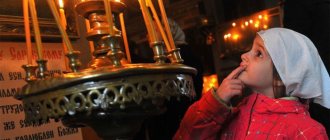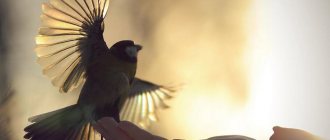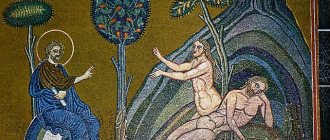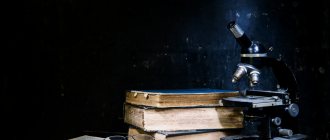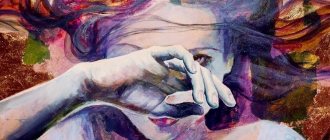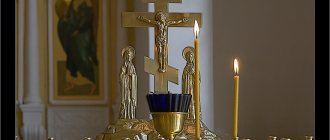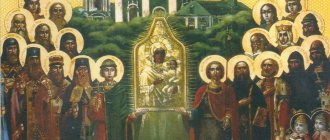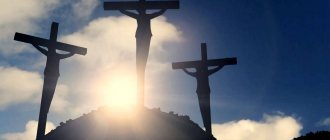History of the Shroud
The Shroud of Turin is a canvas slightly more than 4 meters long and a meter wide. Allegedly, the head, arms and legs of Jesus are “imprinted” on it: you can see the features of a peaceful face that has retained a calm and serene expression. Judging by the prints, part of the funeral shroud was placed under the body of the deceased, and the other was wrapped around the body from the side of the head.
After the death of Christ, the shroud disappeared for more than 13 centuries - the legend continues. People first started talking about it in 1353, when a certain French crusader brought a shroud from his distant travels. There is an opinion that before the sack of Constantinople by Europeans, the shroud was kept there, although there is no reliable evidence of this.
Later, the knight’s family handed over the artifact to the church of the city of Lirey, and from that moment another story of the relic began: strings of pilgrims reached the small town. Interest in the shroud began to fade when the church declared it a fake, of which there were a great many at that time.
However, almost a century later, in 1452, Duke Louis I of Savoy bought the shroud, and it moved to the city of Chambery. In 1578 it was moved to the Cathedral of John the Baptist in Turin in northern Italy. Here she “settled”, receiving her usual name.
However, real fame came to her many centuries later - at the end of the 19th century. In 1898, the Italian lawyer Secondo Pia photographed the shroud and, while working on new photographs, noticed one very strange detail. On the films it was clear that the light and shadow on them seemed to have changed places: the Shroud of Turin was like a negative. Consequently, photographer Secondo Pia ended up with positive photographs in his hands.
This unusual phenomenon attracted a lot of enthusiasts, but no one began to conduct scientific experiments with the shroud at that time. The Church did not want to give the relic to outsiders, although it did not officially confirm its authenticity. However, the technologies of the late 19th century could not provide answers to all the questions of the curious. Scientists began seriously studying the artifact only in the second half of the 20th century.
There are no exact dates for the birth and death of Christ. It is assumed that he was born between 12 and 4 BC. e. His death is usually dated to 26-36. n. e. If you believe some scientists who support the authenticity of the Shroud of Turin, it was made at the beginning of the 1st century AD. e. - during the life and death of Christ.
THE SHROUD OF TURIN: A SCIENTIFIC INVESTIGATION
For centuries, this inconspicuous piece of fabric has haunted believers and non-believers, scientists and clergy, journalists and criminologists. From time to time, disputes flare up about what the Shroud of Turin actually is - a Christian shrine or a fake? A miraculous work or an artist's canvas? No one doubts that this is a document of the era, but it is not clear which one? Doubts are being expressed: is it possible to restore the true history of the object? The journal “Science and Life” has already addressed this topic more than once (see No. 12, 1984; No. 3, 1989; No. 5, 1996). The controversy continues unabated; Not only theologians, but also scientists participate in them. We bring to the attention of readers an article (with minor abbreviations and changes) from the bulletin “In Defense of Science,” published by the commission to combat pseudoscience and falsification of scientific research of the Russian Academy of Sciences.
Science and life // Illustrations
Shroud of Turin. A negative photographic image looks like a positive one.
Image of the head in a positive photo (right) and in a negative photo (left).
Photograph of one of the supposed blood stains on the shroud (right).
Preparation of the shroud for the 1998 exhibition.
Tab. 1. Dating results of the Shroud of Turin.
Tab. 2.
Tab. 3.
‹
›
Just a few years ago, I had no idea about the enormous scale of the debate that unfolded around the Shroud of Turin. All this was very far from my profession - astronomy. But, as it turned out, the focus of the Shroud of Turin intersected not only historical and theological, but also scientific problems. In this article I will briefly talk about them, as well as about some historical and detective episodes accompanying the scientific investigation of this phenomenon.
MYSTERIOUS BLANKET
In the Italian city of Turin, in the Church of St. John, a piece of linen 4.36 m long and 1.09 m wide is kept, in which, according to legend, Jesus Christ was wrapped after being taken down from the cross. The fabric seems to be saturated with pollen and seems to outline faint outlines of flowers, leaves and other parts of plants. On the fabric there are two plain reddish-brown images of a person (front and back views). Without a doubt, the depiction is of a man about 1.8 m tall. Judging by the wounds on the head, arms and legs, it can be concluded that he suffered crucifixion. The nature of the wounds depicted suggests that the man was wearing a wreath of branches with thorns, that he was beaten with sticks and whips, and that he was pierced in the side with a spear. All these tortures, according to the New Testament, were endured by Jesus.
For centuries the painting was the property of the Savoy dynasty. The earliest information about it dates back to approximately 1350: there is written evidence that the owner of the painting was the French knight Geoffroy de Charny, who participated in the Crusades. In 1453, his granddaughter, Margaret of Charny, sold the coverlet to Louis and Anne of Savoy, who first kept it in Chambery and then in Piedmont. In 1532, during a fire, the cover was damaged by molten silver. In 1578 it was transported to where it is kept today - to Turin. In 1983, after the death of the last king of Italy, Umberto II, the shroud came into the possession of the Catholic Church.
The mysterious painting aroused distrust even at the time when it was first presented to the public. This happened in 1355, when Geoffroy de Charny gave the shroud to be displayed to the public in the parish of Liray, southeast of Paris. Soon the place was flooded with pilgrims. In honor of the event, special medallions were made.
Doubts about the authenticity of the shroud are evidenced by archival documents collected by the French priest Ulysses Chevalier and published in 1900 in the essay “A Critical Study of the Origin of the Holy Shroud of Liray-Chambery-Turin.” They say that there was an artist who created the mysterious painting, and that the owner of the shroud could not provide plausible information about how he acquired the shroud. The following fact is also cited: in 1389, the French bishop Pierre Darcy reported to the pope that the church was profiting from a veil painted in a “cunning way.”
WHO IS PICTURED ON THE CANVAS?
In the 20th century, the shroud was exhibited for public viewing several times; her last shows were held in 1978, 1998 and 2000. After the 1978 exhibition, limited research access to the shroud was allowed. Then a group of scientists, mainly from the United States, carried out the first comprehensive examination of the relic. It was concluded that the shroud depicts a real figure of a man subjected to lashing and crucifixion. The blood stains were noted to contain hemoglobin. For believers in the historical authenticity of the shroud, this became a powerful argument in favor.
However, the Catholic Church has never made an official statement regarding the authenticity of the Shroud of Turin. During the public display of the Shroud in Turin on May 24, 1998, Pope John Paul II said: “The Shroud challenges our intellect. She reveals her innermost message only to those who are closest to her with their humble and at the same time lively mind. Its mysterious glow raises questions about the origin and life of a historical figure - Jesus of Nazareth. And since this has nothing to do with questions of faith, the church cannot take upon itself the courage to answer them. She entrusts science with the task of investigating what happened to the linen in which, according to legend, the body of our Savior was wrapped. And the church insists that the results of the study of the shroud be presented to the public. She invites scientists to work with a sense of inner independence and at the same time with attention to the feelings of believers.”
However, many believers treat the Shroud of Turin as a holy relic. For the 1998 exhibition, several books were published, the authors of which tried to prove the authenticity of the veil in the sense of its involvement in the biography of Christ. These researchers call the shroud the word “Sindon”, and themselves - Sindonologists. "Sindon" is a word of Greek origin that originally meant a piece of cloth that could also be used as a shroud, distinguishing it from a face scarf for wiping away sweat. (Another interpretation of this name is based on the supposed place of origin of the shroud, which was called Sidon.) Among supporters of the authenticity of the shroud, the main role is played by the STURP (Shroud of Turin Research Project) group from the USA, created in the 1970s by John Jackson and Eric Jumper.
Sindonologists believe that after being taken down from the cross, Jesus was placed on a blanket, in which he was then wrapped. Therefore, the outline of the body was imprinted on the canvas. Salzburg theology professor Wolfgang Waldstein offers another explanation. He claims that Christ “left his church an image: since there were no press photographers then, he performed a miracle. At the moment of his resurrection on Easter morning, he produced a flash of light, a flash of enormous energy."
To prove that it is Jesus Christ who is depicted on the veil, Sindonologists refer to a large number of signs that are consistent with biblical information. Fans of the shroud also point to other objects with the image of Christ that existed before the 14th century: coins, medallions... They are convinced: the similarity of the depicted faces of Christ proves that even before the 14th century the Shroud of Turin was used as an original for making coins and other works of art.
However, skeptics disagree. If you look closely, they say, the similarity between ancient images of Christ and the imprint on the shroud is not that great. The only coincidence is that everywhere a long-haired, bearded man is depicted. In addition, the question arises: was the bedspread itself created based on some artistic original? In other words, all coincidences can be explained by the commonality of traditions and the desire to preserve them. Even the great theologian Augustine complained that there was no way to know what Jesus looked like. Over time, artists' ideas about the appearance of Christ changed. Until the 3rd century, Jesus was depicted with short hair and no beard. And only later did images of a bearded, long-haired Christ appear. The image on the Shroud of Turin corresponds quite accurately to the traditions of 14th century art. The fact that single-color images were fashionable at the time strengthens the assumption that we are dealing here with the work of an artist.
Of course, art historical analysis is a delicate and ambiguous matter. However, such an analysis was carried out by an Italian commission created in 1973. She concluded that it was "the work of an artist." Art historians believe that the appearance of the image on the shroud corresponds to the ideas accepted after 1300. Historians agree with them; they note that in biblical times, Jews buried their dead with their arms crossed over their chests. Hands folded over the genitals, as depicted on the shroud, first appeared in paintings from the 11th century and were a concession to the prudery of the time. The dead in the time of Christ were buried naked, circumcised and shaved, which also does not correspond to the image on the shroud.
IMAGE TECHNIQUE
The question of how the image was obtained is, of course, the most important. Research in this direction began more than a hundred years ago. A member of the Turin city council, lawyer and amateur photographer Secondo Pia photographed the Turin canvas on May 28, 1898 using a camera on 50 (60 cm) plates. Developing the plates in a darkroom under red light, he noticed a stunning effect: on the negative, all the details were visible much more more clearly than on the positive. The negative itself looked like a positive photograph, which suggests that the image on the shroud is precisely a negative. Many contemporaries did not trust Pia and considered the young art of photography to be charlatanism. But today, the discovery of Pia serves as the main argument among sindonologists supernaturalism of the shroud.
The negative effect can be explained without involving supernatural forces. A painting technique known as "negative image" was used during the Middle Ages. Everyone knows that if you press paper against a coin and rub it with a pencil, you can get a “negative” of the coin. If you use a bas-relief (or a real human body) as a “positive”, then obtaining such an image using the then existing means looks quite probable. However, the image on the Shroud of Turin is not a true negative. If it was a real negative, the dark hair and blood should have looked light in the negative.
In addition, if we accept the hypothesis that the Shroud of Turin actually recorded the original body of Christ, then a number of absurdities are striking:
- when the blanket lies on the human body, it adheres to the surface of the body. Consequently, if you remove and lay out the bedspread, the usual proportions of the body will be distorted in the image. For example, the imprint on the part that envelops the face will be wider than the face as we see it from the front. But there are no such distortions on the shroud;
— there are absolutely no empty spaces that should appear due to folds. The image is too smooth to be genuine;
— the imprint of bloody feet on the bedspread does not geometrically correspond to the position of the legs. The feet of a lying person are usually pointed upward, but here the soles of the feet are on the blanket, and then the knees should be bent;
- the hair of the man depicted on the Shroud of Turin does not fall down, as happens with a lying person, but frames his face, as in paintings;
- hands and fingers of different lengths; so, one arm is 10 cm longer than the other;
- the blood flows as it does in the paintings of second-rate painters: along a small groove, and does not clot, which would be natural. Anyone who has ever had blood on their clothes knows what stains form. Over time they turn black. And the “blood” on the bedspread is still red.
In the book “Jesus did not die on the cross” (1998), journalists E. Gruber and H. Kersten tried to provide experimental evidence that the image could be obtained by the “evaporation” method. Kersten, having been in the sauna, smeared himself with oil and lay down under a linen blanket. An imprint of one side of his body appeared, but without facial features. Judging by the photographs in the book, the print clearly shows that it was taken from a three-dimensional original, for example, there is a definite extension in the hip area. There are no signs of “three-dimensionality” on the Shroud of Turin.
BLOOD OR PAINT?
This question is considered by many to be the most important, but it is also the most confusing. Two chemical analyzes of the fabric and the substance on it were undertaken with the consent of the Catholic Church back in the 1970s. The first analysis was carried out by an Italian commission in 1973 and concluded that it was “the work of an artist.” A reddish granular substance was found on the tissue. All special blood tests were negative.
During the second analysis, in 1978, experts placed 32 adhesive strips on the shroud and then carefully tore them off: 14 strips were taken from the areas of the shroud located around the image of Jesus, 12 strips were glued to the image itself, and 6 were on the “bloody” areas. spots. The strips were cut into two pieces, and one set was given to microanalyst Walter McCrone and the other to Ray Rogers, who examined the particles of matter and fibers of the bedspread adhering to the strips.
McCron found no traces of blood. But he managed to find iron oxide (ferrous ochre) and cinnabar. The old masters obtained this second component from mercury sulfide and used it as a scarlet pigment. Ferrous ocher is only present in the image area itself and is not present in the control areas of the bedspread. And mercury sulphide paint is found exclusively in “bloody” areas. The fact that cinnabar was often used to depict blood in 13th- and 14th-century painting reinforces the idea of the veil as a work of art. All this strengthened McCrone in the opinion that the bedspread had been in the artist’s studio. But since he considered the antique origin of the bedspread to be possible, he concluded that the paint was used additionally for a more expressive restoration of the yellowed stains left by the body on the bedspread. In his 1999 book The Shroud of Turin, McCron cites the following curious incident: his wife, also a researcher, was studying a glue strip from an old French painting. The results of her analysis were so similar to the results of the analysis of the shroud that McCron initially assumed that the wife had accidentally mixed up her stripes with stripes from the shroud in the laboratory. After all, the painting under study was precisely from the country where the Shroud of Turin suddenly appeared in the 14th century. Facts gradually persuaded McCron to believe that the shroud was a man-made product.
However, work on the chemical analysis of the shroud continued: Victor Tryon from the University of Texas in 1998 announced that he had discovered blood on the Shroud of Turin. This was previously stated by Alan Adler and John Geller, members of the STURP group. In fact, they provided evidence of iron and protein on the tissue. But these substances are part of tempera, a water-soluble paint made from egg yolks and iron-containing pigments. The decisive factor here is the fact that no other essential components of blood could be found on the tissue, for example potassium, which is three times more abundant in the blood than iron. However, later reports appeared that traces of DNA were found on the bedspread. The presence of DNA can, of course, indicate the presence of blood, but this is a very weak witness. After so many people have handled the bedspread over the centuries, it would be a miracle if there were no traces of human touch left on it.
I think you will agree with me that the history of research into the Turin blanket is fascinating, like a true detective story. It combines the finest scientific techniques of physicists, biologists and even botanists: fabric, dyes and the smallest particles of pollen stuck in the threads of the fabric are examined and can indicate the route of travel of the canvas. From the huge number of publications, it is difficult to single out reliable and unbiased ones, since research is influenced by the tension associated with the clash of interests of fanatics and scientists, church and science. The above is only a small part of what I learned about the Shroud of Turin during the short time I became interested in it. Anyone interested in the details of her story can easily find them in the literature. And if you use the Internet and type two words into a search engine - “Shroud of Turin”, then the computer will rain down megabytes of information on you. The purpose of this article of mine is different...
When I first became acquainted with the “Turin problem,” I, as a normal graduate of the physics department of Moscow State University, immediately asked myself: “Is it really impossible to objectively measure the age of the canvas and thus try to solve the problem of falsification in one fell swoop? If the painting is not 2000 years old, then it has no connection with biblical stories - it is a fake. And if it is 2000 years old, then it is truly a unique historical monument worthy of attention and deep study.” Having asked myself this question, I quickly discovered that I was not the only one “so smart”: it is the problem of the age of the Turin painting that is now considered the most important and attracts the attention of both serious and not entirely serious scientists.
AGE OF THE CANVAS
Modern scientific methods offer many ways to date a historical monument: physical-chemical, archaeological, art history, theological (correlating biblical texts with the image on the canvas) and others. But to me, as a natural scientist, the physicochemical radiocarbon method, based on the decay of a radioactive carbon isotope and long ago adopted by historians and archaeologists, seems most reliable. The gist of it is this. In the earth's atmosphere, carbon atoms are present in the form of three isotopes: 12C, 13C and 14C. The light isotopes 12C and 13C are stable, but the heavy isotope 14C is radioactive, with a half-life of 5730 years. However, its content in the Earth's atmosphere remains approximately constant (one 14C atom per 1000 billion 12C atoms), since the 14C isotope is constantly formed in the atmosphere from nitrogen atoms under the influence of cosmic rays. Plants, animals and other organisms that maintain gas exchange with the atmosphere absorb 14C and during life contain it in approximately the same proportion as the earth's atmosphere. But when an organism dies, its exchange with the atmosphere stops, 14C is no longer absorbed by tissues and its content begins to slowly decrease as a result of radioactive decay. If you measure the ratio of 14C to 12C in a sample, you can determine the age of the sample, or more precisely, the time that has passed since its death. The fewer 14C atoms left, the older the object.
Of course, the detailed technology for applying the method is not so simple. In principle, if the original 14C content was known, the age of the sample could be directly calculated from the law of radioactive decay. But first you need to make sure that the sample is not contaminated with later carbon. Then you need to take into account that the atmospheric content of 14C fluctuates, since hard cosmic radiation is not constant; In addition, there are variable carbon sources (for example, volcanoes, and in the modern world, the burning of coal and oil) that affect the relative content of 14C. To get rid of these inaccuracies, the method is calibrated using wood samples whose age is precisely known from their growth rings.
Thus, age determination occurs in three stages:
1. The sample is cleaned from random, later impurities.
2. The content of carbon isotopes is measured and, using the decay law, the so-called radiocarbon age (tied to 1950) is calculated, which is calculated in “yr.BP” (years before present) values. But this radiocarbon age is not considered as the true age of the sample, but acts only as a measure of the 14C content. And it does not matter that instead of the real half-life of 5730 years, the so-called Libby half-life (named after the creator of this method, Willard Libby), taken to be 5568 years, is used.
3. Based on the radiocarbon age, using a calibration curve, the calendar date of the sample is determined, which is given in the usual values: years AD or BC.
All these details have long been known to specialists; Isotopic ratios are calibrated across the entire historical time scale using confidently dated samples, including historical sites. The radiocarbon dating method has no fundamental problems.
It is this method that can most accurately determine the age of the linen Shroud of Turin, as historians and archeologists do in relation to all similar monuments of animal and plant origin. In the 1970s and 1980s, scientists repeatedly asked the shroud's owners for permission to conduct precise dating. However, they were refused on the pretext that the research required using a large amount of bedspread fabric. Indeed, in those years, the measurement of the 14C isotope was carried out using the traditional method, determining the radioactivity of the sample using a decay counter. But since the activity is low, samples of relatively large mass were required: in the case of textiles - 20-50 grams, and the fabric would have to be crushed. However, then the isotope ratio began to be determined by mass spectrometry, based on the separation of individual atoms in electric and magnetic fields. The sensitivity of mass spectrometry is very high, so it is enough to have a strip of fabric measuring 7 (10 cm) to make 12 measurements. This circumstance facilitated the decision by the Catholic Church in 1988 to determine the age of the shroud.
Initially, seven laboratories were selected for research. Their list is recorded in the so-called Turin Protocol. However, then friction began between scientists and clergy, and the number of laboratories was reduced to three. The researchers feared that possible random errors in the study of one of the samples would give reason to doubt the reliability of the research (seven samples would significantly increase the reliability). Fortunately, all three laboratories obtained similar results, which indicated that the veil originated between 1260 and 1390. We will return to this later.
However, due to deviations from the Turin Protocol, which the church insisted on, the sampling procedure was changed. Scientists were not allowed to be present when the tissue was taken, continuous and documented identification of samples was not carried out, and the procedure was not recorded with a camera. All this inevitably led to doubts. Although the fear that a random deviation from one of the three laboratories would compromise the overall result was not justified, the lack of a flawlessly executed study protocol still gives rise to various speculations (see Table 1).
But let's get back to the research. So, a sample of the shroud measuring several square centimeters was divided into three parts and sent to three independent scientific institutions: to the geophysics laboratory of the University of Arizona (USA); to the Laboratory of Archeology and History of Art at the University of Oxford, which carried out this work jointly with the research laboratory of the British Museum (UK); and also to the Institute of Physics in Zurich (Switzerland). In each of these laboratories, the samples were divided again, purified in different ways, and their carbon composition analyzed. A total of 12 measurements were made. Comparing the results of the three laboratories gave a radiocarbon age of 691% 31 yr.BP (see table). The calendar age obtained using the calibration curve indicates: with 95% probability, the time of origin of the samples lies between 1262 and 1312 or 1353 and 1384 years (here the objective ambiguity of the calibration curve appeared). The age of 2000 years is practically excluded. Let me remind you that the earliest reliable information about the shroud dates back to approximately 1355. None of the radiocarbon dating participants doubt the medieval origin of the shroud. The result strongly supports the hypothesis that the Shroud of Turin is the work of a 14th-century artist. It would seem that the scientific study of the shroud should end here; but, as it turned out, it’s too early to put an end to this story.
IS IT POSSIBLE TO AGING THE SHROUD OF TURIN?
When I decided to write about the latest scientific research on this historical monument, I did not imagine that I would have to conduct an absentee debate with the luminaries of Russian criminology. However, it is difficult to call this a dispute. Judge for yourself…
In 2001, the journal “Bulletin of the Russian Academy of Sciences” published an article “On the issue of dating the Shroud of Turin.” Its authors: Fesenko Anatoly Vladimirovich - Doctor of Technical Sciences, Head of the Institute of Forensic Science; Belyakov Alexander Vasilievich - head of the Russian Center for the Shroud of Turin; Tilkunov Yuri Nikolaevich - Candidate of Chemical Sciences, Head of Department at the Institute of Forensic Science; Moskvina Tatyana Pavlovna - Candidate of Chemical Sciences, Head of Department of the Ministry of Justice of the Russian Federation. This article expresses doubt about the accuracy of the radiocarbon dating of the shroud carried out by specialists from England, the USA and Switzerland.
The authors of the article indicate that the shroud, which was damaged by a fire in 1532, according to historical data, underwent restoration, during which it could have been soaked in vegetable oils and thus introduced into its composition fresh organic material that could significantly change the ratio of carbon isotopes, and therefore reduce it radiocarbon age. Our criminologists have experimentally shown that the method of preparing shroud samples for radiocarbon dating, used, in particular, by Oxford specialists, does not ensure complete removal of dried vegetable oil from the shroud fabric. If from 7.0 to 15.6% oil was added to the fabric (relative to its initial mass), then after processing there could still be from 1.8 to 8.5% oil left in it. This result looks quite plausible, although I cannot judge the accuracy of the numbers. However, the authors of the article further claim that even 5-7% of oil is enough to “shift” the radiocarbon date of the manufacture of the shroud from the “initial” one (which the authors a priori consider to be the year of the crucifixion of Jesus Christ) to the medieval date obtained in the above-mentioned foreign laboratories.
Agree - amazing result! Are experts from three world countries really this possible source of error? Of course not: just open their work to see that they took this possibility into account. Listing the various sources of error that affect the accuracy of radiocarbon dating, they point out that when measuring textile samples, the main danger is contamination, especially from fat, oil or soot, that is more recent than the sample itself. The fact that different samples in each laboratory were cleaned using different methods (including ultrasound), and the results of individual measurements were in good agreement with each other, suggests that the role of contamination was insignificant. In addition, if the shroud was made in the 1st century, then even 10% of its contamination with oil in 1532 gives an error of about 280 years old, that is, it “rejuvenates” the shroud to the 3rd-4th centuries AD, but not to XIV century. If the fabric was made in the 14th century, then 10% oil contamination in the 16th century would reduce its radiocarbon age by only 40 years. And finally, in order to rejuvenate the shroud by 1300 years - from the era of Jesus Christ to the mid-14th century - it is necessary to saturate the fabric with an amount of oil whose weight is several times greater than the weight of the fabric itself. And this is obvious nonsense.
So what is the find of Russian criminologists? How did they manage to rejuvenate the shroud by 13 centuries with no more than 7% oil contamination? It’s very simple: they did this through a gross mathematical error, writing the isotope ratio equation in such a form as if at the moment of contamination only the radioactive carbon isotope 14C got into the fabric of the shroud, and not a natural mixture of all carbon isotopes! It's hard to believe that this is an accidental mistake. From this equation, the authors calculate what the radiocarbon date of birth of the shroud, created in the early 1st century, would have been if there had been a certain percentage of unaccounted oil contamination (see Table 2).
The authors stop here, and we, using their equation, will continue the table (see Table 3)
It was no coincidence that we identified contamination at 8.7%; As we see, it is with this content of unwashed oil that, according to the calculations of our criminologists, the radiocarbon age of the shroud would coincide with the date of its contamination. It doesn’t take much of a scientist to understand that such rejuvenation is only possible if the substance of the ancient tissue is completely replaced by fresh organic substance produced in 1532. Completely, not 8-9%. The last columns of the table look like complete fantasy: with 11.5% contamination produced in the 16th century, the fabric of the shroud should be made today! Well, then she found herself in the era of Jesus Christ... You can’t do without a time machine!
To tell the truth, I am sorry that our criminologists were not able to have their say in the world “shroudology.” After all, there are probably competent specialists among them, and the task is certainly interesting for them. But how could experienced experts fail to notice such an obvious mistake? I won’t guess, I’m an astrophysicist, not a detective.
For the sake of objectivity, we can recall that in the discussion around the shroud, mistakes and even pitfalls were made before. For example, in 1989, physicist Thomas Phillips of Harvard University's High Energy Laboratory suggested that at the moment of Christ's resurrection, his body emitted a powerful pulse of thermal neutrons (and why not - what do we know about the physics of the resurrection?). At the same time, some nuclei of the 13C isotope, capturing neutrons, could turn into 14C nuclei, thus “rejuvenating” the fabric of the shroud from the point of view of radiocarbon studies. Although it was clear to everyone that this idea belonged to the category of “Physicists are joking,” it was carefully analyzed by experts. Arguments have been found, such as the normal isotopic composition of other chemical elements in the tissue, that completely reject this hypothesis.
Sometimes one hears reproaches that serious scientists are trying to brush aside the problem of the Shroud of Turin, that science is not able to unravel the nature of this historical monument. This is strange to hear: any document of the 14th century (and even more so of the 1st century!) is infinitely valuable for science, for the history of culture. That is why scientists are so meticulously striving to establish its authenticity. To establish the true, and not the mythical, history of the Shroud of Turin is the goal of scientific research. Unfortunately, this cultural monument never fully fell into the hands of scientists. But even the little that qualified researchers have been able to do is mentioned by some “commentators” in passing or with obvious distortions. I am sure that over time the mystery of the Shroud of Turin will be solved: scientists have also uncovered not such secrets!
LITERATURE
Arutyunov S., Zhukovskaya N. The Shroud of Turin: a body imprint or an artist’s creation // Science and Life, 1984, No. 12, p. 102.
The face on the shroud // Science and Life, 1996, No. 5, p. 49.
Surdin V.G. Error in solving an elementary problem // Bulletin of the RAS, 72, 2002, No. 6, p. 543-544.
The Shroud of Turin is the creation of an artist // Science and Life, 1989, No. 3, p. 157.
Fesenko A.V., Belyakov A.V., Tilkunov Yu.N., Moskvina T.P. On the issue of dating the Shroud of Turin // Bulletin of the Russian Academy of Sciences, 2001, No. 10, p. 915-918.
Chernykh E.N. Biocosmic “clocks” of archeology // Nature, 1997, No. 2, p. 20-32.
Damon PE, Donahue DJ, Gore BH, Hatheway AL, Jull AJT, Linick TW, Sercel PJ, Toolin LJ, Bronk CR, Hall ET, Hedges REM, Housley R., Law IA, Perry C., Bonani G., Trumbore S ., Woelfli W., Ambers JC, Bowman SGE, Leese MN, Tite MS Radiocarbon Dating of the Shroud of Turin // Nature, 1989, v. 337, p. 611-615.
G ove H . E. Relic, Icon or Hoax - Carbon Dating the Turin Shroud. — Institute of Physics Publishing. London, 1996.
Gruber E.R., Kersten H. Das Jesus-Komplott. — Langen Mueller, Muenchen, 1992.
Nickell J. (1998a) Inquest on the Shroud of Turin.—Latest Scientific Findings. Prom. Books., Amh., NY.
Was Christ an albino?..
The main question can be formulated this way: why is the Shroud of Turin considered authentic? The fact is that on it you can see not only body prints, but also traces of wounds. Frightening evidence of crucifixion, numerous blows with a whip, and finally, bruises where the spear of a Roman legionnaire struck - all this was “imprinted” on the relic.
Peter Paul Rubens, “The Descent from the Cross” / ©Cathedral of Our Lady of Antwerp
There is one interesting point here that is not always mentioned. In the Christian tradition, it is customary to depict the crucified Christ with nails hammered into his palms. In real Ancient Rome, they nailed their wrists. On the Shroud of Turin it is clearly visible that the nails were driven into the wrists.
Does this prove its authenticity? One should not rush to conclusions, because the shroud could have been forged by a skilled hoaxer - a master who was familiar with ancient Roman customs much better than an ordinary priest of the Middle Ages.
Is it possible to analyze the blood residues on the shroud? Alas, even in our age it is impossible to say with certainty whether there is blood on it - studies cannot confirm either its presence or its absence.
Scientists are more likely to believe that the stains on the shroud are only dyes, mercury sulphide and ocher. It would seem that the issue can be closed, however, artists tried to copy the image of the shroud more than 50 times, including using new methods, but they failed to achieve the same result.
As we have already mentioned, what attracted the public's attention was the fact that the image of Jesus was preserved in negative form. Some explain this by the “fabric illumination effect” of the canvas. There is also a hypothesis about a primitive camera that could have been used to make a fake.
However, if the image on the shroud is truly negative, then Jesus Christ will turn out to be... an albino with white hair and a beard of the same color. Many researchers, however, do not consider the version of the negative image on the shroud. They believe that part of the fabric was simply exposed to stronger sunlight, which is why this effect occurred.
There is one strong proof of the authenticity of the shroud. In 1976, scientists at Los Alamos National Laboratory placed its image into the VP-8 computer, which could interpret the optical density of the image and turn a flat image into a relief one. The results were unexpected: a three-dimensional image of a person appeared on the screen.
The believers received a serious trump card, but the skeptics did not give up: even if the shroud is not a simple image, this does not at all mean that the body of the messiah was wrapped in it. To make the shroud, the hoaxer could have used some kind of model, and possibly a real human body.
Exposition of the Shroud of Turin in St. John's Cathedral ('s-Hertogenbosch, Netherlands) / ©Flickr/Anja
"The Fifth Gospel"
“If confirmed to be authentic, it will become the Fifth Gospel – another historical account of the passion and resurrection of Jesus Christ. The Gospels mention that Jesus Christ was scourged before His crucifixion, but only the Shroud “tells” us how cruel it was. There were two soldiers who scourged Jesus Christ, and their scourges had metal spikes. Apparently there were at least forty blows, and they covered the entire back, chest and legs.
The Gospels say that the executioners placed a crown of thorns on the head of Jesus Christ in mockery. From the Shroud we learn that this was not only a method of humiliation, but also a continuation of torture. The thorns of the crown of thorns were so sharp that they pierced the vessels on the head and blood flowed abundantly through the hair and face of Jesus Christ. Exploring the Shroud, you can see the Passion of Christ - the beating in prison, His bearing of the cross, His fall under the burden from exhaustion" (Orthodox physicist, director of the Russian Center for the Study of the Shroud of Turin, Alexander Vasilyevich Belyakov).
For Christians, one thing remains indisputable: history does not know anyone who was beaten, crucified on the Cross, was wrapped in a shroud, but did not remain in it for more than two days. No one except Jesus Christ, who voluntarily accepted death on the Cross for the redemption of all mankind and resurrected on the third day after His death.
Late dating
The easiest way to dispel myths about the authenticity of the shroud is to prove that it was made in the Middle Ages. But everything is not as simple as counterfeit supporters thought. Back in the 1950s of the 20th century, scientists drew attention to the fact that the primitive structure of the fabric indicates its early origin. According to the conclusions of those times, the shroud could have been made back in the 1st century AD - that’s when Christ lived.
The most famous experiments with the shroud were carried out in 1988. Three independent laboratories at once - Oxford and Arizona universities, as well as the Federal Polytechnic Institute in Zurich - received samples of the shroud in order to establish its age by radiocarbon dating.
To the disappointment of many believers, all three laboratories provided similar results - the shroud was made no earlier than the 13th century. There could be no question of any ancient origin of the canvas.
Needless to say, the story did not end there. Lovers of mysticism and simple believers insisted that the shroud was subjected to third-party influence, which distorted the test results. Indeed, in 1532, the shroud was burned in a fire in Chambery, and patches were applied to the shroud. Could scientists have drawn the wrong conclusion with more recent tissue at hand? It is unlikely, because it is very easy to distinguish the original weaving from medieval patches. It is unlikely that the results of the experiment could have been influenced by other external influences, for example, coloring. If the shroud had been contaminated with something, it could have played a role, but not so much as to make a mistake for a thousand years. In any case, most scientists think so.
In 2001, the Bulletin of the Russian Academy of Sciences published an article by specialists from the Institute of Forensic Science of the FSB of Russia, the Center for the Shroud of Turin and the Ministry of Justice of the Russian Federation. It claimed that the radiocarbon dating could have given incorrect results because the shroud contained medieval oils. Thus, the age of the canvas “accidentally” shifted by 1300 years. After the publication of the material, other researchers conducted a number of new analyzes. It turned out that the oil content in the canvas could introduce an error of 276 years, but not thirteen centuries. Let us also note that the authors of the above article never had real samples; all their conclusions are based on photographs of the shroud.
Cathedral of John the Baptist in Turin, where the shroud is located / ©depositphotos.ru
Mentions in documents
According to church traditions preserved in Georgia and Armenia, the cloth with which Christ was wrapped was preserved by the Apostle Peter. It may have remained in Palestine until the 7th century. Between 660 and 680 the shroud was seen by the Frankish bishop Ar-kulf, who made a pilgrimage to Jerusalem. The shroud, folded in a compact manner, could then go to Edessa, where it was known as the Mandylion. Further, the relic is mentioned in the capital of the Byzantine Empire. The testimony of the 13th century French knight Robert de Clary, who described the capture of Constantinople by the crusaders, is noteworthy: “And among these other miracles there was another monastery there, which was called the name of the Holy Virgin Mary of Blachernae, in this monastery there was a shroud with which our Lord was wrapped; this shroud was opened slightly every Friday, so that the face of our Lord could be clearly seen, and no one - neither Greek nor French - ever knew what became of this shroud when the city was taken" (translation by Mikhail Zaborov). In Byzantium, there was a type of icon “Christ in the tomb,” where the Savior stands in the tomb naked to the waist, with his hands folded on his chest or stomach (in rare full-length versions, on his genitals). The folds on the shroud suggest that it was folded 8 times in such a way that only the upper part of Christ’s body appeared before the believers. The fact that the Shroud of Turin was used in worship in Byzantium is also indicated by symmetrical holes with burnt edges. They could have appeared as a result of an accidental fall of coal from a censer. After the defeat of Constantinople, the relic fell either into the hands of one of the feudal lords (for example, the Otgon of the case of Roche, who captured the Church of the Virgin of Blachernae), or to the Knights Templar. Sindologist Ian Wilson identified the shroud with the Templar shrine, called “The Head”. One way or another, there is no reliable description of the path of the shroud from Constantinople to France. Another thing is more important - in Byzantium after 1204 it was no longer mentioned.
"Conspiracy Around Jesus"
There are also very strange theories. There is a version of the German writer Holger Kersten, according to whom the results of the 1988 experiments were correct, but the samples themselves... were replaced. This “hypothesis” is supported by the fact that half an hour of filming actually mysteriously disappeared from the laboratory records that recorded everything that was happening. During this time, the fabric of the shroud could well have been replaced.
The writer does not limit himself to the story of the theft of the canvas, questioning even the official position of the church regarding Christ. It is the church, according to Kersten’s version, that is behind the falsification of experiments, and its reasons are the most compelling.
Allegedly, the Shroud of Turin contains evidence that at the time of His removal from the cross, Christ was not dead at all. According to Kersten, the wounds of a dead person simply could not bleed like that and would not leave such marks on the canvas.
But how could Jesus Christ survive the execution? According to the German writer, the followers of Christ initially had clear plans to save their messiah. He was taken down from the cross three hours after the crucifixion. Indeed, many of the condemned hung on the cross for more than five days, and some of them even survived. Christ lost consciousness after a wet sponge was brought to his face, which could contain some kind of sedative. Thus, the overseers could be misled by supporters of Jesus Christ.
Theoretically, at the time of his removal from the cross he could still have remained alive, but these are just guesses. The main and, in fact, the only evidence of Kersten’s version is the Gospel. In the morning the tomb was found empty - says the Holy Scriptures.
Kersten's theory can also explain the appearance of body prints on the shroud. To heal wounds, followers of Christ could use aloe and myrrh oils, and it was they that caused the stains on the canvas. All this and much more was described in the book The Conspiracy Around Jesus by Holger Kersten and Elmar Gruber.
However, the founder of this conspiracy theory can hardly be called a scientist. It is known that he worked at a Sunday school in Freiburg, after which he decided to devote himself to travel and a writing career. In addition to the book “The Conspiracy Around Jesus,” Kersten published another work with a flashy title: “Jesus Lived in India.” The titles alone are enough to draw certain conclusions about the level of these works.
©depositphotos.ru
The radiocarbon dating method is based on measuring the ratio of the 14C isotope to stable carbon isotopes. The radiocarbon method is very complex and requires the highest qualifications - there are cases where the results of experiments were turned upside down. However, almost always such an analysis allows one to obtain very accurate and reasonable results.
Compliance with the Biblical Text
According to the Gospel of Matthew, after the execution of Jesus, a rich man, Joseph from Arimathea, came to Pontius Pilate and asked to give him the body of the crucified man. “Taking the body, Joseph wrapped it in a clean shroud and laid it in his new tomb, which he carved into the rock,” says the evangelist. In the original Greek of the New Testament, the word σινδών (sindon) is used in this place. As the Russian pre-revolutionary biblical scholar Alexander Lopukhin explained, it meant thin linen or paper material that was delivered to the Roman Empire from India (“the country of Sind”). However, an analysis of the fabric of the Shroud of Turin showed that it was woven from flax, which did not grow in India, but probably in Asia Minor. The structure of the fabric differs from ordinary Jewish paintings of the 1st century, but similar fabric, and quite expensive, was made in those days in the neighborhood of Palestine, in Damascus. The only Gospel in which the burial of Christ is described in a fundamentally different way than in the other three is the Gospel of John, it says that the body of Jesus was wrapped in “swaddling clothes with incense, as the Jews usually bury.” It is assumed that the evangelist meant ribbons about 30 centimeters wide. They were used, for example, at the burial of Lazarus, about whom the Gospels say that he was “wrapped hand and foot in burial shrouds.” However, it is possible that John simply used a stable verbal formula, and in fact Joseph buried Jesus not entirely according to Jewish traditions. After all, Jesus and His disciples did not follow many of the requirements of the Law of Moses. The same Lopukhin noted that the word “sindon” was used by Herodotus when talking about the funeral rites of Egypt (Jesus lived in this country for some time as a child). “Comparing the news of the burial of Christ with these Egyptian rites, one can come to the conclusion that Joseph and Nicodemus intended to embalm the body of Christ,” the researcher noted. There was much controversy regarding the position of the shroud in relation to the body. The Russian Synodal Translation of the Bible says that Joseph “wound” the body of the Savior. Other translations use the verbs “wrapped” or “wrapped.” But if the fabric had fit tightly to the body, then the image on the shroud would probably have been an expanded and flattened “scan”. In reality, there is a direct projection, as if the upper and lower pieces of the syndon were spread out. It can be assumed that the evangelist Matthew did not know the appropriate Greek word. But the fabric could also well have straightened out, saturated with fumes from myrrh and aloe, with which Joseph rubbed the body of Jesus (he spent about 100 liters of incense). Some researchers find confirmation of the description of the Passion on the Shroud of Turin - for example, traces of blows from a whip or pricks of a crown of thorns. However, image quality does not always allow such significant details to be distinguished from random spots. Much more interesting is the discovery of blood particles (methemoglobin) on the tissue, presumably belonging to Jesus Christ. Scientists found that she had the fourth group (AB). These data coincide with blood tests on another relic, the sudarium from Oviedo (presumably the scarf that was used to wrap Christ’s head after his execution).
In pursuit of sensation
Years go by, but interest in the Shroud of Turin does not fade. And although access to the relic is limited, after 1988 scientists were able to conduct several more experiments.
Last year, the scientific world was shocked by the results of new research. University of Padua professor Julio Fanti decided to refute the conclusions of studies from the late 1980s. The original samples of the Shroud of Turin were subjected to infrared spectroscopy, as well as mechanical analyses. The research results completely contradicted the results of radiocarbon dating: according to Giulio Fanti, the Shroud of Turin may be three centuries older than Christ himself!
Criticizing the results of previous experiments, the professor did not say anything new. The fire and the use of oils allegedly played a cruel joke on scientists, causing them to make a thousand year mistake in dating. This version is set out in detail in Fanti’s book “Secrets of the Shroud,” co-written with journalist Saverio Gaeta. As in the case of Kersten, the classic pattern of “incredible discovery” can be traced here. All this is very reminiscent of a cheap sensation.
One of the latest studies was the work of Italian physicists Giuseppe Lacidogna, Alberto Carpinteri and Oscar Borla from the Politecnico di Turin, the results of which were published in 2013. Like Giulio Fanti, scientists criticized the findings of the 1988 experiment, only now the focus was not on fire or flood, but on earthquake. Allegedly, shortly before the execution of Christ, an earthquake occurred in Judea, which changed the properties and orientation of the particles on the canvas.
Naturally, this version also does not have any scientific evidence, and it is unlikely that it will appear. There are many seismically active places, but such phenomena have not been observed there.
The Shroud of Turin is a single piece of cloth, but the ancient Jews, as far as can be judged, used several pieces of fabric rather than whole shrouds in ritual rites. One of these panels, for example, was used to cover the head of the deceased. It turns out that the version of the authenticity of the shroud contradicts ancient Jewish customs.
©Flickr/John Mosbaugh
Nature of the image
The greatest mystery of the Shroud of Turin, testifying to its authenticity, is the image itself. The Italian Secondo Pia, who photographed the shrine in 1898, was the first to notice that the image on the fabric was a negative. Accordingly, a positive film appeared before him on the negative film. The dark areas became illuminated, the light areas darkened - and the surprised photographer saw the hazy but realistic face of a long-haired man. The image on the shroud was not made with paints - it is formed by darkening of the linen fiber. Simply put, some energy “scorched” the tissue. There. Where parts of the body were closer to the shroud, dark areas appeared, and where further away, lighter areas appeared. The mechanism of dehydration and oxidation that led to this is partly similar to the cause of yellowing of newsprint when exposed to direct sunlight. However, if there was simply a flash of light, the image would appear blurry. Scientists have put forward different versions of what kind of radiation created the drawing - radioactive, neutron, and the like. One of the most interesting is the “fiery body” hypothesis, which was proposed by the director of the Russian Center for the Shroud of Turin, Alexander Belyakov. “At the moment of Jesus’ resurrection, His body was filled with some kind of “immobile” energy unknown to us, and the energy density decreased with distance from the body,” the researcher explained in an interview in 2010. “We can calculate this dependence, display it on a graph, and using the graph we can then see what features on the fabric could have arisen. So, the graph gives exactly those features that we see on the Shroud. But if it were ordinary “moving” energy, manifested in radiation or diffusion, then such an image would not have happened.” It is possible that the body of Christ lost its usual material structure and the tissue simply fell off as it passed through it. This explains the emergence of direct projection. Another argument in favor of this version is the faded image of a face on the back of the shroud, discovered in 2004. Candidate of Philological Sciences, Deacon Vladimir Vasilik, discovered that in the Byzantine tradition of hymnography there are indications precisely of the “fiery body” of Christ. For example, in the canon for the week of Doubting Thomas, composed by John of Damascus, there are such remarkable lines. O truly commendable Thomas of terrible boldness! I will boldly touch your rib with the shining divine fire. Skeptics who consider the shroud to be a medieval fake have proposed various methods for obtaining a similar imprint, mainly chemical ones. However, it is not possible to experimentally create a clear image similar to that presented on the shroud, even in the 21st century. It is even more unrealistic that such methods of falsification were used in the Middle Ages.
Copies
At the moment, scientists have learned to make copies of the Shroud of Turin using high technology. The original was exhibited only four times during the twentieth century, and is scheduled to be exhibited next in 2025.
There are 6 copies of the shroud in the world and one of them is in Metropolitan Russia. She was blessed by Vladimir of Ladoga.
